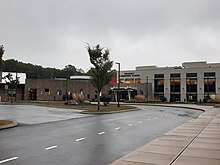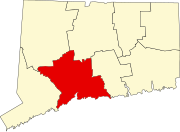Prospect, Connecticut
[2] It is a suburb of the nearby city of Waterbury to its north, and is on the north-eastern fringes of the New York metropolitan area.
Prospect is an exurban town, with residents often traveling to other major cities and employment centers across the state.
What is known is that the town rested near the border zone of the Quinnipiac and Tunxis peoples, and it was known that the area served as a hunting and fishing ground for both tribes.
"[7]: 29 The land was then first surveyed in 1697, and divided into four tracts, starting from the Waterbury border, and advancing towards Cheshire in half-mile intervals.
[7]: 30 The first European settlers in what would become the town of Prospect arrived in 1712, building homes in the "West Rocks" near the then boundary line of Waterbury and Cheshire.
[7]: 104 The town used to produce wood, charcoal, hay, ice, apples, cider, milk, butter, cheese, eggs, wool, flax, corn, rye, barley, and oats.
This led to the highest concentration of industry in the town being located in the Rag Hollow area, near the border of Cheshire.
[7]: 112 The town was also where the first parlor matches were made in the United States, with the factory of Ives & Judd producing them.
[7]: 110 The town's brief foray into manufacturing came to a close by the twentieth century, with operations halting and entrepreneurs leaving for Waterbury, Naugatuck, Cheshire, or even New York.
At this time, the Grange hall, the Congregational church, and three street lights made up the initial electric customers.
[10][11] Most town residents and businesses rely on septic systems for discharge, and wells for water.
Those who lost their homes found refugee in Prospect's Community School, where they received medical attention and temporary housing.
It was the largest mass murder in Connecticut history until the Sandy Hook Elementary School shooting.
The name originates from an early 1990s article in Connecticut Magazine which ranked Prospect as the worst small town in the entire state.
The measurement was done based on its school system, economy, the cost of living, crime rate and cultural resources.
Neighboring towns are Waterbury to the north, Cheshire to the east, Bethany to the south, and Naugatuck to the west.
The town is notable for rocky soil, deposited during the retreat of the glaciers around 11,000 years ago.
Oaks are the most abundant tree in the town, although in the swamp areas, the Red Maple dominates.
Like Connecticut, Prospect frequently experiences Nor'easters and Blizzards during the winter, which can bring heavy snowfall to the town.
George Sabo, the incumbent chief administrative officer, won election as the town's first mayor over his Republican opponent, Ronald Dreher.
A total of nine members are elected every two years, and the town charter mandates that no political party have a majority larger than one seat.
Just prior to the construction of the town hall the government met in the back of Oliver's Supermarket (now LaBonne's Market).
The composition of the Board of Education was originally slated to be split evenly between the two towns, which was agreed upon prior to the referendum approving the merger.
[25] According to a March 1976 Supreme Court ruling which upheld an earlier decision, the principle of One man, one vote applied to the Boards of Education of regional school districts.
Beacon Falls then attempted to dissolve the regional school district, which at the time only officially contained Long River Middle School, on the basis that the Supreme Court ruling now constituted a breach of contract between Beacon Falls and Prospect.
[30] Funding for Region 16, which today controls and operates four schools, is based on the number of students from each town attending the district.



